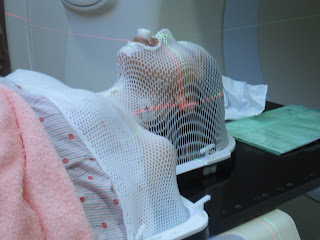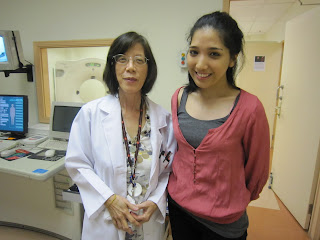Front view - Mid-week 1
WHAT ACTUALLY HAPPEN IN THE RADIATION TREATMENT ROOM
My visit to the radiotherapy chamber was more or less the same: 20 minute each at most. The first week was a breeze and the treatment showed no severe side effects other than tiredness following the treatment. Dry mouth had started and I felt very thirsty - so liquids must be handy. I also experienced soreness in the throat.
First I was required to lie on the treatment tabletop. The radiotherapists then spent a lot of time aligning a green laser beam to the two “tattoo” marks on both my shoulder made during the planning stage. They measured with special rulers to the half milimetre, checking measurements they had on a Computer screen monitor both in the room and outside the treatment room at their workstations. The measurements were done in the planning stage in the Simulator Room.
Once they got the alignment correct, they would fit in the mask and fixed it onto the treatment tabletop. There were so many masks in the room! (see picture below) They will then leave me alone in the room for the X-ray treatment first. Outside they have a monitor of the room focused on the treatment bed; only the radiotherapist can see me in the room. After the X-ray was taken, they would come in and tell me that the Radiotherapy session will begin soon.
Then the radiotherapist will come back and say they are done for the day and would clean the markings they made earlier with alcohol prep pads. Sounds simple, really.

‘Cycle’ used to be such an innocent word for me. But with my treatment being administered in cycles (six of them), the word now connotes many things – ups and downs, highs and lows… and doing things over and over. Try to imagine a roller coaster with six gut-wrenching peaks and drops, and you are seated in the front for its first free-fall - that sums up exactly how I felt about chemo.
Chemo is typically given in cycles, with rest periods between the cycles. This allows the cancer cells to be attacked at their most vulnerable times, and allows the body’s normal cells time to recover from the damage.
The cycle begins...
November 23: I was accompanied by Mom and Sara for my first chemotherapy session. We were at the door of the SDMC Cancer Day Care at 8am and already there was a crowd. Prior to the treatment, complete blood counts, or CBCs were performed to check the number of each type of blood cell circulating in the body. CBC notes the red blood count, platelets and white blood count. My weight was also taken as it is vital that I maintain a healthy weight throughout my treatment.
Normal ranges for CBCs:
- Hemoglobin (HgB) – Normal (Female): 12 - 16 g/dL
- White blood cells – Normal (Female): 4-11 k/ul
- Platelets – Normal: 150 to 400 ('000) cells/mm3
- Weight – Not less than 50kg
- Hemoglobin (HgB) – 12.4
- White blood cells – 5.58
- Platelets – 233
- Weight – 53.6kg
- Result = PROCEED!






I was exhausted as the chemicals kicked in and slept immediately after dinner.
The first cycle felt like a breeze, until the next day when I felt like life was being drained out of me. The main challenge was to combat nausea and to continuously eat as I had really lost my appetite (the pre-cancer Aida only eats twice a day and now I have to eat 5x a day!). I am grateful that I have my loved ones to go through this ordeal. I wouldn’t have the courage to go through this alone.















































